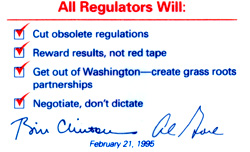
Presidential Directives
Plain Language Action Group
The New OSHA: Reinventing Worker Safety and Health
Feature Stories
Speeches
News Releases
Regulatory Reports
U.S. Business Advisor
What Companies Are Saying about Reinventing Regulation
10/20/98: Washington Post Reports: USDA Shift Puts Safety in Packer's Hands
OSHA's November 13, 1998 Partnership Conference Brochure (Graphic file requires
Adobe Acrobat Reader)
4/8/99: Reinvention Spotlight: EPA's Sustainable Industry Program
|
|
|
We have worked since 1993 to bring common sense to the world of federal
regulations. In September of that year, what was then the National
Performance Review published
"Improving Regulatory Systems," which made a
number of recommendations. The report called for, among other things, more
innovative approaches to regulation, streamlining of agency rulemaking
procedures, and enhanced public awareness and participation.
Many of these recommendations were implemented by President Clinton's
Executive Order #12866. Agencies began consulting more with stakeholders and
streamlining the rulemaking process.
Despite these efforts, dissatisfaction with the regulatory process
continued. In late 1994, Vice President Gore called on his regulatory
workgroup (mandated by the executive order) to get "out-of-the-box" and
consider dramatically different models to meet their regulatory
responsibilities. The Vice President introduced the idea of customer service
for regulated industries--that "good players" who want to comply with
federal regulations often need information and assistance. He encouraged
agencies to:
- use targeting to reach the most egregious offenders,
- develop incentives to encourage exemplary behavior, and
- use the worldwide web to deliver fast, real-time information.
Most importantly, the Vice President called on federal regulators to form
partnerships with the community they regulated to explore even more
groundbreaking ways to achieve goals like clean air and safe food.
In February 1995, to reinforce the work of the Vice President and his
regulatory workgroup, the
President met with regulators. He directed them to:
- Cut obsolete regulations,
- Reward results, not red tape,
- Get out of Washington-create grass roots partnerships, and
- Negotiate, don't dictate
The President followed this up in April that year with a second directive
that told regulators to do two additional things:
- Apply fines to fixes-allow companies which
have been acting in good faith to apply any fine they have been assessed to
fixing the problem that led to the fine in the first place
- Reduce reporting burden-double the time that
passes between required reports, i.e. a report that had been required once a
year could now be submitted biannually.
As a result, regulators eliminated 16,000 pages of unnecessary
regulations and rewrote another 31,000 so they made sense. Regulators are
talking to the communities they regulate and forming partnerships to share
information, to provide joint training, to explore new technology, and to
save resources. As a result, tons of toxic emissions have been eliminated,
workers are safer in the workplace, and groundbreaking new drugs are moving
to patients much more quickly.
On June 1, 1998, the
President signed a new directive to federal
agencies to write all documents designed to educate the public in plain
English. This includes all new regulations. By writing clearly and giving
people the information they need to comply with federal regulations, burden
goes down while compliance goes up. For more information on NPR's Plain
English initiative, go to www.plainlanguage.gov.
In the months ahead, we'll provide examples of some of these
regulatory innovations and the success they've shown, see below. We'll focus
on three areas: partnerships; information; and results.
|

